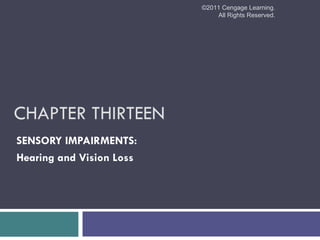More Related Content Similar to Human Exceptionality Chapter 13 (20) 2. CHAPTER FOCUS POINTS
Focus 1
Describe how sound is transmitted through the human ear.
Focus 2
Distinguish between the terms deaf and hard-of-hearing.
Focus 3
What are the estimated prevalence and the causes of hearing loss?
Focus 4
Describe the basic intelligence, speech and language skills, educational
achievement, and social development associated with people who are
deaf or hard-of-hearing.
©2011 Cengage Learning.
All Rights Reserved.
3. CHAPTER FOCUS POINTS
Focus 5
Identify four approaches to teaching communication skills to
persons with a hearing loss.
Focus 6
Why is the early detection of hearing loss so important?
Focus 7
Distinguish between the terms blind and partially sighted.
Focus 8
What are the distinctive features of refractive eye problems,
muscle disorders of the eye, and receptive eye problems?
©2011 Cengage Learning.
All Rights Reserved.
4. CHAPTER FOCUS POINTS
Focus 9
What are the estimated prevalence and the causes of vision loss?
Focus 10
Describe how a vision loss can affect intelligence, speech and language
skills, educational achievement, social development, physical orientation
and mobility, and perceptual-motor development.
Focus 11
Describe two content areas that should be included in educational
programs for students with vision loss.
Focus 12
Why is the availability of appropriate health care social services
important for people with vision loss?
©2011 Cengage Learning.
All Rights Reserved.
5. INTRODUCTION
There are misconceptions regarding the quality of life
of those with sensory impairments.
Sensory loss does not automatically equate to a life of
deprivation, loneliness and complete frustration.
To others without sensory loss such a life would seem
frightening
Most lead active, productive lives
©2011 Cengage Learning.
All Rights Reserved.
6. CASE STUDY: TAMIKA
Born with severe hearing loss in both ears
Hated being teased about hearing aids
Learned to read lips; watches the speaker intently
Is the all-star forward for the W.N.B.A.’s Indiana
Fever; two time Olympic Gold Medalist
A future goal is to open a full-service community
center with basketball courts, fitness equipment,
computer rooms and a reading corner.
©2011 Cengage Learning.
All Rights Reserved.
7. AUDITION
The act or sense of hearing
The ear is the mechanism through which sound is
collected, processed, and transmitted to a
specific area in the brain that decodes the
sensations into meaningful language.
©2011 Cengage Learning.
All Rights Reserved.
8. DEFINITIONS/TYPES
OF HEARING LOSS
Deaf
Hard-of-hearing
Age of onset
Prelingual
Postlingual
Anatomical site of loss
Conductive loss
Sensorineural loss
Mixed hearing loss
©2011 Cengage Learning.
All Rights Reserved.
9. CLASSIFICATION
Severity of condition
Caution must be used
Must consider
Intelligence
Emotional stability
Early education and training
Family environment
Occurrence of other disabilities
©2011 Cengage Learning.
All Rights Reserved.
10. PREVALENCE
Hearing loss gets worse over time
Estimated 28 million people have hearing loss
Approximately 11million have significant irreversible
hearing loss
1 million are deaf
Only 5% are under 17 years of age
43% are over 65 years of age
©2011 Cengage Learning.
All Rights Reserved.
11. CAUSATION
Congenital Factors
Heredity
Prenatal disease
Acquired factors
Postnataldisease
Environmental factors
©2011 Cengage Learning.
All Rights Reserved.
12. CHARACTERISTICS
Intelligence
Speech and English language skills
Educational Achievement
Social Development
Adjustingto the hearing world
The deaf culture
©2011 Cengage Learning.
All Rights Reserved.
15. HEALTH CARE AND SOCIAL
SERVICES
Health care specialists
Geneticist
Pediatricianand family practitioner
Neurosurgeon
Otologist
Audiologist
©2011 Cengage Learning.
All Rights Reserved.
16. HEALTH CARE AND SOCIAL
SERVICES
Social consequences
Highly correlated to severity of disability
Social inclusion may be difficult.
Social rights may be withheld or hard to obtain.
17. CASE STUDY: JOHN
Born premature
Likes being blind; his perception is that it’s fun
Loves technology; not fond of outdoor activities
Uses Braille and a cane to maneuver through the world
Is very positive about his abilities and goals in life
©2011 Cengage Learning.
All Rights Reserved.
18. VISUAL PROCESS
Very complex
Helps us gain information beyond the other senses
The way we perceive visual stimuli provides
foundation for the development of more complex
learning structures.
©2011 Cengage Learning.
All Rights Reserved.
19. DEFINITIONS
Blindness
Partial sight (low vision)
©2011 Cengage Learning.
All Rights Reserved.
20. CLASSIFICATION
Refractive eye problems
Muscle disorders
Receptive eye problems
©2011 Cengage Learning.
All Rights Reserved.
21. PREVALENCE
Difficult to determine
20% of Americans have some kind of vision loss; most
can be corrected
1 in 3,000 children are legally blind
5% of children have serious eye disorder; this figure
increases to 20% when looking at people over 65
50% of people over the age of 65 have vision loss
when cataracts are included
©2011 Cengage Learning.
All Rights Reserved.
22. CAUSATION
Genetic disorders
Acquired disorders
©2011 Cengage Learning.
All Rights Reserved.
23. CHARACTERISTICS
Intelligence
Speech and language skills
Academic achievement
Social development
Orientation and mobility
Perceptual-motor development
©2011 Cengage Learning.
All Rights Reserved.
24. EDUCATIONAL SUPPORTS AND
SERVICES
Assessment
Mobility training and daily living skills
Instructional content
Communication media
©2011 Cengage Learning.
All Rights Reserved.
25. EDUCATION IN THE LEAST
RESTRICTIVE ENVIRONMENT
Open and closed residential facilities
Based on principle of flexible placement
Full continuum of services recommended
©2011 Cengage Learning.
All Rights Reserved.
26. HEALTH CARE AND SOCIAL
SERVICES
Health care specialists
Prevention
Treatment
Social consequences
May have social adjustment difficulties
May lack self-esteem
Socialization services should begin early.
©2011 Cengage Learning.
All Rights Reserved.
27. LOOKING TO A BRIGHT FUTURE
Advanced technology offers a wider variety of ways
in which children with sensory impairments can
communicate and interact with their peers and the
world in which they live.
Research on effective methods of education enables
students who are sensory impaired to be included in
their neighborhood schools and learn side-by-side
with hearing peers.
©2011 Cengage Learning.
All Rights Reserved.

